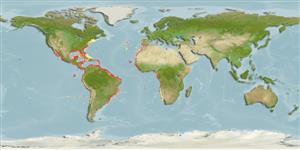Common names from other countries
Environment: milieu / climate zone / depth range / distribution range
Ecologia
marinhas; Água doce; estuarina associadas(os) a recifes; catádromo (Ref. 51243); intervalo de profundidade 0 - 300 m, usually 0 - 20 m. Subtropical; 43°N - 34°S, 114°W - 16°E
Western Atlantic: Nova Scotia, but uncommon north of Cape Cod (Harrison, pers. Comm.) to Argentina (Ref. 74796). Eastern Atlantic: Senegal River outlet (Ref. 57400) southwards up to Namibia (Ref. 81659). Eastern Pacific: Gulf of California to Chile (Ref. 9321, 81659).
Length at first maturity / Tamanho / Peso / Idade
Maturity: Lm 19.7, range 21 - ? cm
Max length : 91.0 cm TL macho/indeterminado; (Ref. 81659); common length : 30.0 cm TL macho/indeterminado; (Ref. 9321); peso máx. Publicado: 680.00 g (Ref. 40637)
Espinhos dorsais (total): 4 - 5; Raios dorsais moles (total): 8-9; Espinhos anais 3; Raios anais moles: 9 - 10. Diagnosis: body stout, rounded in cross-section; head broad; inter-orbital space flat; a well developed adipose eyelid covering most of pupil (Ref. 57400). Upper lip simple, thicker and deeper than in most Mugil species, armed with 2-3 rows (Ref. 57400), teeth in outer row curved, monocuspid (Ref. 57400, 81659) and moderately close-set (Ref. 81659) or widely spaced (Ref. 57400), inner row of less closely set, smaller teeth may be present just posterior to outer row (Ref. 81659). Lower lip with single row of unicuspid teeth, usually smaller than teeth in outer row on upper lip (Ref. 81659). A vertical line from hind end of upper jaw positioned midway between posterior nostril and anterior eye margin; maxillary pad not visible below corner of mouth when closed; origin of 1st dorsal fin equidistant from snout tip and caudal-fin base; pectoral axillary process well developed (30-37% of pectoral-fin length)(Ref. 57400). (Second) dorsal and anal fins entirely (and more or less densely) covered with scales (Ref. 57400, 81659). Anal fin usually III-9 (rarely III-10) in adults (usually II-10 in juveniles <30 mm SL), first spine very short and usually hidden by overlying scales (Ref. 81659). 11-13 scale rows between origins of first dorsal and pelvic fins (Ref. 57400, 81659).
Inhabit sandy coasts and littoral pools but also occurs in muddy bottoms of brackish lagoons and estuaries. Sometimes penetrate rivers. May also be found on coral reefs (Ref. 9710). Juveniles are common in coastal waters and are known to find their way to estuaries and coastal lagoons. Growth in juveniles is moderate (30-40 cm in 4 years). Adults form schools (Ref. 9321). Feed on microscopic or filamentous algae and small juveniles of planktonic organisms (Ref. 9626). Reproduction occurs between March and August. Spawn several million eggs provided with a notable yolk (Ref. 35237). Oviparous, eggs are pelagic and non-adhesive (Ref. 205). Maximul size 910 mm TL for western Central Atlantic specimens, eastern Central Atlantic specimens may reach 350 mm TL and commonly reach 250 mm TL (Ref. 81659). An important foodfish, it is marketed fresh and salted (Ref. 9321).
Robins, C.R. and G.C. Ray, 1986. A field guide to Atlantic coast fishes of North America. Houghton Mifflin Company, Boston, U.S.A. 354 p. (Ref. 7251)
Categoria na Lista Vermelha da IUCN (Ref. 130435)
CITES (Ref. 128078)
Not Evaluated
Ameaça para o homem
Harmless
Utilização humana
Pescarias: espécies comerciais; Aquacultura: espécies comerciais; isco: occasionally
Ferramentas
Relatórios especiais
Descarregue XML
Fontes da internet
Estimates based on models
Preferred temperature (Ref.
115969): 21 - 28, mean 26.1 (based on 798 cells).
Phylogenetic diversity index (Ref.
82804): PD
50 = 0.5000 [Uniqueness, from 0.5 = low to 2.0 = high].
Bayesian length-weight: a=0.01175 (0.01004 - 0.01375), b=2.94 (2.91 - 2.97), in cm Total Length, based on LWR estimates for this species (Ref.
93245).
Nível Trófico (Ref.
69278): 2.0 ±0.0 se; based on diet studies.
Resiliência (Ref.
120179): Médio, tempo mínimo de duplicação da população 1,4 - 4,4 anos (tm=2-3; Fec=>50,000).
Fishing Vulnerability (Ref.
59153): High vulnerability (56 of 100).
